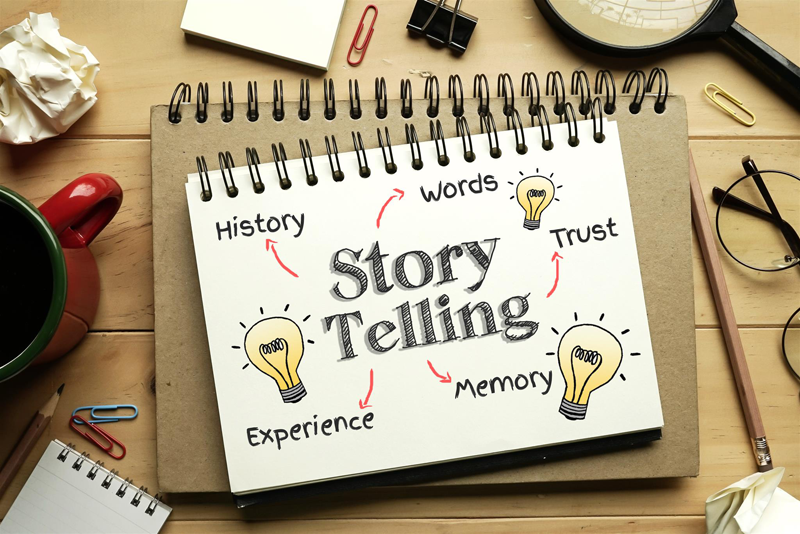Telling your brand story

What is story telling in marketing?
Human brains are hardwired to tell stories. If a light comes on in your car then your bran will turn this into a story of how some vital part is in danger of breaking, that you will take it to the garage, that the garage owner will bill you thousands of pounds, you won’t be able to pay, now you can’t drive… or work… you will end up on the streets living in a cardboard box. And, all that actually happened was an LED lit up behind your steering wheel.
This is the curse of our brains – but this is the gift to the marketer.
Storytelling is a powerful means of bringing a product or brand to life in the mind of the consumer. The prospect will start to engage emotionally with what once was an inanimate object or two-dimensional service. With the use of the story you can engage with the human challenges and hopes that drive your consumer and so help a product or service to resonate.
What makes a brand story so effective?
A brand story is not really the history of the brand. There are times when offering a history is effective – when the heritage of the company is part of the emotional resonance you are manufacturing. However, a brand story is something entirely more fictional than a dry “about us” page on a website. The brand story needs to evoke an emotional reaction – and drive what people say about you.
Your brand will have a story attached to it, whether you like it or not. You may be known around the local area as the coffee shop with the best pie on sale, or the grumpiest till operators in any supermarket or the car showroom that offers nice coffee. The job of the marketer is to shape the narrative and to make the narrative more global than local.
You begin your narrative with your logo, the font used for your name, in the design of your shop – and in the compilation of your mission statement and values. And all these need to cohere. You will then communicate all this in your in-store, online, and media communication to your customer – and it will all join to give a clear story about who you are and what you believe in.
A clear and consistent brand story inspires trust. But, powerful brand stories build emotional connections with the audience and form a community that transcends commercial gains. Look at the power of the brand story behind Disney, with its all-American family imagery – or the iconic Apple – with it brand story on design and innovation – with luxury at affordable prices.
The guide to telling your brand story
The steps to telling a brand story are easy to synthesise but harder to implement. Here are the essentials that you will want to realise in your marketing:
- Know your audience and know them well. You want to know what they would connect with – this might not be where they are right now but where they aspire to be. It might be that they are a mid-level IT geek lost in a large corporate entity – but they aspire to be the next huge games developer that leads a whole community. Show you know them and show that you know where they would like to be – and be the loyal partner in realising their vision.
- Once you know the person you are connecting with find the right way to position your brand to attract them. You have decided who they are and what they need but now think: how your product will fulfil this, and in a way better than any competitor could. This is your positioning statement and should reveal the sentiment you want to evoke.
- Find someone to be your brand persona. You need a person for people to connect with.
- Be honest as much as possible because people expect to be manipulated and are surprised by authenticity. Stay true to the original vision and mission you established, and you will continue to stay real in the minds of the consumer.
- You want to go viral. There needs to be something within your brand story that makes people want to share it with others. Word of mouth is still the most powerful way to win traffic and conversions. This means that there needs to be something about your brand story that gets people talking.
In short, the brand story needs to be true, to be human, to be different from your competitors and serve the emotional and psychological needs of your customer. Easy, right?
Tips for ultimate success
All of this is fine – but what is the essential ingredient that will make your brand story work?
Well, the story needs to be driven through personality for ultimate success. Elon Musk – Tesla; Mark Zuckerberg – Facebook; Steve Jobs – Apple; Richard Branson – Virgin. Behind the brand is a persona that the consumer can empathise with, admire or maybe even resent a little. Whatever the reaction – the use of a person evokes an emotional reaction – and this is the power of brand story telling. Even if we are challenged by the persona – we are also drawn into the story of their genius, their thought-leading and at times their fallibility.
It is not the biography of these people that is important – it is the personality that is communicated – which should be married with the vision and mission of the company. This might be entirely fictional – but will resonate with enough honesty that the audience are compelled to trust the image projected.
People trust people not organisations. Therefore, at the core of your brand story should be a personality that people can connect with.


